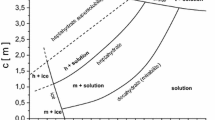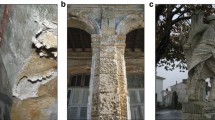Abstract
To assess salt damage risks in building materials and geomaterials, the key components to identify are the accumulation of salts and the damage propagation. Experimental data combining both are scarce but offer an additional richness for understanding the coupling between transport and mechanics in the context of salt crystallization in porous media. Here, we quantify the drying of sodium sulfate and sodium chloride solutions from Savonnières limestone together with the damaging character of anhydrous sodium sulfate and halite precipitation, respectively. Repeated wetting–drying cycles are performed, by using salt solutions in the rewetting phase and by drying at an elevated temperature of 45 °C. The drying and deformation dynamics are characterized by means of high-resolution neutron radiography, with a moisture content resolution of 0.04 kg/m3 and a spatial resolution of 13.5 μm/pixel. Precipitation occurs inside the specimen by treating the upper volume of the specimen hydrophobically. High Peclet numbers are found, representing a long first drying stage leading to salt accumulation in a localized zone, increasing the damage risk. In-pore crystallization of halite during drying of 5.8 molal sodium chloride solutions is particularly damaging for our type of samples. Large deformations are observed already during the first cycle, indicative of crack formation. With 1.4 molal sodium sulfate solutions, no damage is observed upon precipitating the anhydrous sodium sulfate crystal, but the drying rate decreases with every cycle due to augmented pore clogging.









Similar content being viewed by others
References
Derluyn, H.: Salt transport and crystallization in porous limestone: neutron—X-ray imaging and poromechanical modeling. Diss. ETH No. 20673 (2012)
Derluyn, H., Griffa, M., Mannes, D., Jerjen, I., Dewanckele, J., Vontobel, P., Sheppard, A., Derome, D., Cnudde, V., Lehmann, E., Carmeliet, J.: Characterizing saline uptake and salt distributions in porous limestone with neutron radiography and X-ray micro-tomography. J. Build. Phys. 36, 353–374 (2013). https://doi.org/10.1177/1744259112473947
Derluyn, H., Dewanckele, J., Boone, M.N., Cnudde, V., Derome, D., Carmeliet, J.: Crystallization of hydrated and anhydrous salts in porous limestone resolved by synchrotron X-ray microtomography. Nucl. Instrum. Methods Phys. Res. Sect. B Beam Interact. Mater. At. 324, 102–112 (2014a). https://doi.org/10.1016/j.nimb.2013.08.065
Derluyn, H., Moonen, P., Carmeliet, J.: Deformation and damage due to drying-induced salt crystallization in porous limestone. J. Mech. Phys. Solids. 63, 242–255 (2014b). https://doi.org/10.1016/j.jmps.2013.09.005
Desarnaud, J., Bertrand, F., Shahidzadeh-Bonn, N.: Impact of the kinetics of salt crystallization on stone damage during rewetting/drying and humidity cycling. J. Appl. Mech. 80, 020911 (2013). https://doi.org/10.1115/1.4007924
Desarnaud, J., Derluyn, H., Molari, L., de Miranda, S., Cnudde, V., Shahidzadeh, N.: Drying of salt contaminated porous media: effect of primary and secondary nucleation. J. Appl. Phys. 118, 114901 (2015). https://doi.org/10.1063/1.4930292
Dreesen, R., Dusar, M.: Historical building stones in the province of Limburg (NE Belgium): role of petrography in provenance and durability assessment. Mater. Charact. 53, 273–287 (2004). https://doi.org/10.1016/j.matchar.2004.07.001
Espinosa-Marzal, R.M., Hamilton, A., McNall, M., Whitaker, K., Scherer, G.W.: The chemomechanics of crystallization during rewetting of limestone impregnated with sodium sulfate. J. Mater. Res. 26, 1472–1481 (2011). https://doi.org/10.1557/jmr.2011.137
Flatt, R.J.: Salt damage in porous materials: how high supersaturations are generated. J. Cryst. Growth 242, 435–454 (2002). https://doi.org/10.1016/S0022-0248(02)01429-X
Flatt, R.J., Mohamed, N.A., Caruso, F., Derluyn, H., Desarnaud, J., Lubelli, B., Espinosa-marzal, R.M., Pel, L., Rodriguez-navarro, C., Scherer, G.W., Shahidzadeh, N., Steiger, M.: Predicting salt damage in practice: a theoretical insight into laboratory tests. RILEM Tech. Lett. 2, 108–118 (2017). https://doi.org/10.21809/rilemtechlett.2017.41
Grementieri, L., Molari, L., Derluyn, H., Desarnaud, J., Cnudde, V., Shahidzadeh, N., De Miranda, S.: Numerical simulation of salt transport and crystallization in drying Prague sandstone using an experimentally consistent multiphase model. Build. Environ. 123, 289–298 (2017). https://doi.org/10.1016/j.buildenv.2017.06.049
Hassanein, R.K.: Correction methods for the quantitative evaluation of thermal neutron tomography, PhD Thesis, ETH Zurich, Switzerland, Diss. ETH No. 16809 (2006)
Hassanein, R., Lehmann, E., Vontobel, P.: Methods of scattering corrections for quantitative neutron radiography. Nucl. Instrum. Methods Phys. Res. Sect. A Accel. Spectrom. Detect. Assoc. Equip. 542, 353–360 (2005). https://doi.org/10.1016/j.nima.2005.01.161
Hassanein, R., Meyer, H.O., Carminati, A., Estermann, M., Lehmann, E., Vontobel, P.: Investigation of water imbibition in porous stone by thermal neutron radiography. J. Phys. D Appl. Phys. 39, 4284–4291 (2006). https://doi.org/10.1088/0022-3727/39/19/023
Kaestner, A.P., Hartmann, S., Kühne, G., Frei, G., Grünzweig, C., Josic, L., Schmid, F., Lehmann, E.H.: The ICON beamline—a facility for cold neutron imaging at SINQ. Nucl. Instrum. Methods Phys. Res. Sect. A Accel. Spectrom. Detect. Assoc. Equip. 659, 387–393 (2011). https://doi.org/10.1016/j.nima.2011.08.022
Lubelli, B., van Hees, R.P.J., Groot, C.J.W.P.: The role of sea salts in the occurrence of different damage mechanisms and decay patterns on brick masonry. Constr. Build. Mater. 18, 119–124 (2004). https://doi.org/10.1016/j.conbuildmat.2003.08.017
Lubelli, B., Vanhees, R., Huinink, H., Groot, C.: Irreversible dilation of NaCl contaminated lime–cement mortar due to crystallization cycles. Cem. Concr. Res. 36, 678–687 (2006). https://doi.org/10.1016/j.cemconres.2005.10.008
McGreevy, J.P., Smith, B.J.: Salt weathering in hot deserts: observations on the design of simulation experiments. Geogr. Ann. Ser. A Phys. Geogr. 64, 161–170 (1982)
Pel, L., Landman, K.A., Kaasschieter, E.F.: Analytic solution for the non-linear drying problem. Int. J. Heat Mass Transf. 45, 3173–3180 (2002). https://doi.org/10.1016/S0017-9310(02)00025-X
Perfect, E., Cheng, C.L., Kang, M., Bilheux, H.Z., Lamanna, J.M., Gragg, M.J., Wright, D.M.: Neutron imaging of hydrogen-rich fluids in geomaterials and engineered porous media: a review. Earth-Sci. Rev. 129, 120–135 (2014). https://doi.org/10.1016/j.earscirev.2013.11.012
Petkovic, J.: Moisture and ion transport in layered porous building materials: a nuclear magnetic resonance study, PhD Thesis, TU Einhdoven, The Netherlands (2005)
Pleinert, H., Körner, S., Lehmann, E.: Neutron signal transfer analysis. Nucl. Instrum. Methods Phys. Res. Sect. A Accel. Spectrom. Detect. Assoc. Equip. 424, 177–182 (1999)
Poupeleer, A.S.: Transport and crystallization of dissolved salts in cracked porous building materials, PhD Thesis, KU Leuven, Belgium (2007)
Rard, J.A., Miller, D.G.: The mutual diffusion coefficients of Na2SO4–H2O and MgSO4–H2O at 25 C from Rayleigh interferometry. J. Solut. Chem. 8, 755–766 (1979a)
Rard, J.A., Miller, D.G.: The mutual diffusion coefficients of NaCl–H2O and CaCl2–H2O at 25 C from Rayleigh interferometry. J. Solut. Chem. 8, 701–716 (1979b)
Rengasamy, P.: Salinity in the landscape: a growing problem in Australia. Geotimes 53, 34–39 (2008)
Rodriguez-Navarro, C., Doehne, E.: Salt weathering: influence of evaporation rate, supersaturation and crystallization pattern. Earth Surf. Process. Landf. 24, 191–209 (1999). https://doi.org/10.1002/(SICI)1096-9837(199903)24:3%3c191:AID-ESP942%3e3.0.CO;2-G
Rodriguez-Navarro, C., Doehne, E., Sebastian, E.: How does sodium sulfate crystallize? Implications for the decay and testing of building materials. Cem. Concr. Res. 30, 1527–1534 (2000). https://doi.org/10.1016/S0008-8846(00)00381-1
Roels, S.: Modelling unsaturated moisture transport in heterogeneous limestone, PhD Thesis, KU Leuven, Belgium (2000)
Roels, S., Carmeliet, J.: Analysis of moisture flow in porous materials using microfocus X-ray radiography. Int. J. Heat Mass Transf. 49, 4762–4772 (2006). https://doi.org/10.1016/j.ijheatmasstransfer.2006.06.035
Scherer, G.W.: Theory of drying. J. Am. Ceram. Soc. 73, 3–14 (1990)
Schiro, M., Ruiz-Agudo, E., Rodriguez-Navarro, C.: Damage mechanisms of porous materials due to in-pore salt crystallization. Phys. Rev. Lett. 109, 265503 (2012). https://doi.org/10.1103/PhysRevLett.109.265503
Shahidzadeh-Bonn, N., Rafaï, S., Bonn, D., Wegdam, G.: Salt crystallization during evaporation: impact of interfacial properties. Langmuir ACS J. Surf. Colloids 24, 8599–8605 (2008). https://doi.org/10.1021/la8005629
Shahidzadeh-Bonn, N., Desarnaud, J., Bertrand, F., Chateau, X., Bonn, D.: Damage in porous media due to salt crystallization. Phys. Rev. E 81, 1–6 (2010). https://doi.org/10.1103/PhysRevE.81.066110
Steiger, M., Asmussen, S.: Crystallization of sodium sulfate phases in porous materials: the phase diagram Na2SO4–H2O and the generation of stress. Geochim. Cosmochim. Acta 72, 4291–4306 (2008). https://doi.org/10.1016/j.gca.2008.05.053
Trtik, P., Lehmann, E.H.: Progress in high-resolution neutron imaging at the Paul Scherrer Institut—the neutron microscope project. J. Phys. Conf. Ser. (2016). https://doi.org/10.1088/1742-6596/746/1/012004
Trtik, P., Hovind, J., Grünzweig, C., Bollhalder, A., Thominet, V., David, C., Kaestner, A., Lehmann, E.H.: Improving the spatial resolution of neutron imaging at Paul Scherrer Institut—the neutron microscope project. Phys. Procedia 69, 169–176 (2015). https://doi.org/10.1016/j.phpro.2015.07.024
Tsui, N., Flatt, R.J., Scherer, G.W.: Crystallization damage by sodium sulfate. J. Cult. Herit. 4, 109–115 (2003). https://doi.org/10.1016/S1296-2074(03)00022-0
van Hees, R.P.J., De Clercq, H., Quist, W.J.: Stenen van binnen, stenen van buiten. Natuursteen in de jonge bouwkunst. Syllabus 4de Vlaams-Nederlandse Natuursteendag., Delft (2012)
Viles, H.A.: Implications of future climate change for stone deterioration. Geol. Soc. Lond. Spec. Publ. 205, 407–418 (2002). https://doi.org/10.1144/gsl.sp.2002.205.01.29
Waters, L.S.: MCNPX User’s Manual Version 2.3.0, Report LA-UR-02-2607 (2002)
Acknowledgements
This work is based on experiments performed at the ICON beamline, Swiss spallation neutron source SINQ, Paul Scherrer Institute, Villigen, Switzerland. The technical help of Stephan Carl and Roger Vonbank (Empa) for building the experimental setup, and of Jan Hovind (PSI) for mounting of the setup inside the beamline, is gratefully acknowledged.
Author information
Authors and Affiliations
Corresponding author
Ethics declarations
Conflict of interest
The authors declare that they have no conflict of interest.
Data availability
The neutron datasets analyzed during the current study are available via sending a request to the corresponding author.
Electronic supplementary material
Below is the link to the electronic supplementary material.
Rights and permissions
About this article
Cite this article
Derluyn, H., Vontobel, P., Mannes, D. et al. Saline Water Evaporation and Crystallization-Induced Deformations in Building Stone: Insights from High-Resolution Neutron Radiography. Transp Porous Med 128, 895–913 (2019). https://doi.org/10.1007/s11242-018-1151-x
Received:
Accepted:
Published:
Issue Date:
DOI: https://doi.org/10.1007/s11242-018-1151-x




